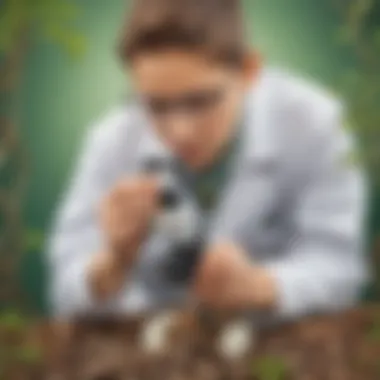Unveiling Unique Plant Science Fair Ideas for Young Minds to Explore


Science Fun Facts
Did you know that plants can communicate with each other through underground networks of fungi? This fascinating process, known as mycorrhizal networks, allows plants to share nutrients and information. Imagine a secret language underground - isn't nature marvelous?
Plants are not just stationary organisms; they can exhibit movement. For instance, the sensitive plant, scientifically known as Mimosa pudica, responds to touch by folding its leaves inward. It's like a shy plant that doesn't want to be touched!
Discover the Wonders of Science
When we explore plant science, we uncover a realm of captivating phenomena. From photosynthesis, where plants magically transform light into food, to seed germination, where tiny seeds sprout into thriving plants, the world of botany is brimming with marvels.
Imagine watching time-lapse videos of seeds growing into plants. Witness the magic of life unfolding in a fast-forward mode. These visual representations not only educate but also inspire a deeper appreciation for the natural world.
Science Quiz Time
Are you ready to put your plant knowledge to the test? Here's a fun quiz for young botanists: What is the process through which plants make their food? A) Photosynthesis B) Respiration C) Digestion. Test your knowledge and uncover fascinating facts about how plants sustain themselves.
Let's engage in a plant-themed brain teaser: I start with a seed and end with a new plant, what am I? Ponder over this puzzle and discover the life cycle of a plant in an interactive way.
Science Experiment Showcase
Welcome to the hands-on section where scientific exploration comes to life! Let's conduct a mesmerizing experiment to observe water transportation in plants. Gather a white flower, water, and food coloring. Dip the flower's stem in colored water and witness the petals change color as the plant absorbs water.
In this step-by-step guide, we'll explore the wonders of germination. Grab a few seeds, soil, and a small pot. Plant the seeds, water them gently, and watch as tiny seedlings emerge from the earth. It's like witnessing nature's magical rebirth up close.
Introduction to Plant Science
The realm of plant science serves as a fascinating gateway into the intricate world of botany, offering young minds a rich tapestry of knowledge to unravel. This section delves into the fundamental aspects of botany, unraveling the mysteries of plant biology and shedding light on the crucial role of plants in our ecosystem. Through a series of engaging discussions, we aim to cultivate a profound appreciation for the wonders of nature, igniting a spark of curiosity that will inspire the next generation of budding scientists to explore the marvels of the plant kingdom.
Understanding Plant Biology


Photosynthesis and its Significance
Embark on a journey through the captivating process of photosynthesis, a vital mechanism through which plants harness the power of sunlight to synthesize nutrients. Discover the intricate dance of light and chlorophyll as plants convert carbon dioxide into oxygen, unraveling the significance of this life-sustaining process. Delve into the profound implications of photosynthesis on the ecosystem and explore the unique adaptation of plants to optimize this essential biological function for their survival.
Plant Growth and Development
Witness the miracle of plant growth and development as seedlings transform into majestic trees, illustrating the remarkable journey of life inherent in every plant. Dive deep into the intricate mechanisms that drive root and shoot growth, unraveling the complexities of hormonal signaling and environmental influences on plant development. Explore the nuances of cellular division and expansion that underlie the flourishing existence of plants in diverse habitats around the globe.
Adaptation of Plants to their Environment
Delve into the fascinating realm of plant adaptations, where organisms evolve unique traits to thrive in varying environmental conditions. Explore how plants have adapted over millennia to conquer extreme temperatures, arid landscapes, and nutrient-deficient soils, showcasing the resilience and versatility of nature's botanical wonders. Unravel the genetic and physiological mechanisms that drive these adaptations, offering insights into the intricate dance between plants and their environment.
Importance of Plants in Our Ecosystem
Plants stand as silent sentinels of our ecosystem, playing a pivotal role in sustaining life on Earth through their remarkable contributions. From the bountiful oxygen they provide through photosynthesis to the crucial role they play in food chains and biodiversity, plants form the bedrock of our ecological balance. Explore the interconnected web of life where plants serve as the cornerstone, driving nutrient cycles, regulating climate, and providing habitats for diverse organisms to thrive.
Oxygen Production and Carbon Sequestration
Marvel at the sheer magnitude of oxygen production by plants, a process that forms the basis of aerobic life on our planet. Delve into the intricate exchange of gases, where plants inhale carbon dioxide and exhale life-sustaining oxygen, detoxifying our atmosphere and ensuring a breathable environment for all living beings. Uncover the critical role of plants in carbon sequestration, acting as guardians against escalating carbon levels and mitigating the impacts of climate change through their carbon-storing abilities.
Role in Food Chains and Biodiversity
Embark on a journey through the intricate food chains where plants form the foundational link, channeling solar energy into the trophic levels to sustain diverse ecosystems. Explore the dynamic interactions between plants, herbivores, and predators, witnessing the delicate balance that supports biodiversity and ecosystem resilience. Unveil the profound impact of plant diversity on the stability of food webs, highlighting the importance of conserving native plant species for the continuity of life on Earth.
Innovative Plant Science Fair Ideas
Hands-On Plant Experiments
Effect of Light on Plant Growth
Embarking on the exploration of the effect of light on plant growth opens a gateway to comprehend the essential role light plays in nurturing plant life. This particular experiment sheds light on how plants respond to varying light intensities and the significance of light in the process of photosynthesis. The unique feature of this experiment lies in its tangible demonstration of how different light conditions impact plant development, providing a hands-on experience that enhances the understanding of plant biology among young scientists in an engaging manner.


Watering Techniques and Plant Health
Diving into the realm of watering techniques and plant health offers a holistic understanding of the vital role water plays in sustaining plant life. This experiment delves into the impact of different watering frequencies and methods on plant vigor and overall health. By highlighting the dynamic relationship between watering practices and plant vitality, young scientists can grasp the significance of proper hydration for plant growth. This hands-on experiment not only instills practical skills but also nurtures an appreciation for attentive plant care among budding botanists.
Soil Types and Plant Nutrition
Exploring the diverse world of soil types and their impact on plant nutrition unlocks a realm of knowledge regarding the intricate link between soil composition and plant growth. This experiment focuses on contrasting soil types and their respective effects on plant health and nutrient absorption. By highlighting the unique characteristics of different soil varieties and their implications for plant nutrition, young scientists can gain a comprehensive understanding of the crucial role soil plays in fostering healthy plant development. This experiential learning opportunity paves the way for young minds to appreciate the intricate ecosystem supporting plant life and growth.
Interactive Plant Projects
DIY Terrarium Building
Venturing into the realm of DIY terrarium building provides an avenue for young scientists to delve into the art of creating self-contained miniature ecosystems. This project not only nurtures creativity but also enhances the understanding of plant care and ecosystem dynamics. The key characteristic of this project lies in its hands-on nature, empowering young learners to design and cultivate their miniature botanical world. By engaging in terrarium building, young scientists develop a sense of responsibility towards plant care and environmental stewardship while exploring the wonders of self-sustaining ecosystems.
Plant Life Cycle Observations
Engaging in plant life cycle observations unveils the captivating journey of plant growth and development, allowing young scientists to witness firsthand the transformative stages of a plant's life. Observing the germination, growth, and reproduction phases offers a profound insight into the intricate mechanisms governing plant life cycles. The unique feature of this project lies in its interactive nature, enabling young scientists to delve into the nuances of plant biology through direct observation and analysis. By immersing in plant life cycle observations, budding botanists can cultivate a deep appreciation for the beauty and resilience of plant life.
Botanical Drawing and Labeling
Embarking on the creative endeavor of botanical drawing and labeling nurtures not only artistic expression but also a deeper understanding of plant anatomy and classification. This project emphasizes the importance of accurate representation and labeling in botanical studies, honing young scientists' observational skills and attention to detail. The key characteristic of this project is its fusion of art and science, encouraging young learners to explore the intricacies of plant morphology through a creative lens. By engaging in botanical drawing and labeling, young scientists can enhance their botanical knowledge while fostering a creative outlet for self-expression and exploration.
Guidelines for Plant Science Fair Presentations
Plant Science Fair Presentations play a pivotal role in fostering a love for botany among young minds. These guidelines offer a structured approach to showcase scientific exploration and learnings. By emphasizing the importance of clear communication and engaging displays, participants can effectively convey their findings to an audience. Incorporating these guidelines not only enhances the learning experience but also encourages creativity and critical thinking in young scientists.
Creating Engaging Displays
Visual Appeal and Organizational Skills
Visual appeal and organizational skills are fundamental aspects of any plant science fair presentation. The visual presentation of data and information is crucial in capturing the audience's attention and conveying the research effectively. Organizational skills ensure that the content is structured logically, making it easier for viewers to follow the scientific journey presented. The combination of visual appeal and organizational skills creates a comprehensive and engaging display, enhancing the overall impact of the presentation.


Incorporating Scientific Methodology
Incorporating scientific methodology is essential in plant science fair presentations as it adds a layer of credibility and rigor to the research showcased. By following defined scientific methods, participants can validate their findings and ensure the reliability of their experiments. Scientific methodology emphasizes the importance of precision, accuracy, and reproducibility, establishing a strong foundation for presenting scientific information. Integrating scientific methodology into presentations demonstrates a commitment to sound scientific principles and enhances the quality of the overall project.
Effective Communication of Findings
Presenting Data and Observations Clearly
Clear presentation of data and observations is key to effectively communicate findings in plant science fair presentations. Using visual aids, such as graphs, charts, and images, helps in simplifying complex information and making it more accessible to the audience. Clarity in presenting data ensures that the audience can easily grasp the results of the experiment and understand the implications of the research conducted. By presenting data and observations clearly, participants can showcase their scientific discoveries in a compelling and understandable manner.
Encouraging Audience Participation
Audience participation plays a vital role in enhancing the interactive nature of plant science fair presentations. By engaging the audience through interactive activities, question sessions, or demonstrations, presenters can create a dynamic and immersive experience. Audience participation not only stimulates interest and curiosity but also fosters a sense of involvement and excitement among attendees. Encouraging audience participation adds a layer of interactivity to the presentation, making it more memorable and impactful for viewers.
Inspiring Plant Science Fair Themes
In the vibrant realm of scientific exploration, the significance of inspiring plant science fair themes cannot be overstated. These themes serve as the bedrock for cultivating young minds' curiosity and nurturing a deep-seated passion for botany. By delving into sustainable gardening practices and innovations in plant biotechnology, young scientists between the ages of 6-12 can unravel the captivating world of plants in a hands-on and interactive manner.
Sustainable Gardening Practices
Composting and Recycling Initiatives
Exploring the domain of composting and recycling initiatives within the context of plant science not only promotes eco-conscious behaviors but also underscores the crucial role of sustainability in our ecosystem. Children engaging with composting and recycling initiatives are exposed to the cyclical nature of plant life, enhancing their understanding of environmental processes. The key characteristic of composting and recycling initiatives lies in their ability to minimize waste and enrich soil health, all while instilling responsible stewardship towards our planet. While composting and recycling initiatives present numerous advantages, it is essential to guide young scientists on the intricacies of proper waste management and the benefits it brings to creating a more sustainable world.
Conservation of Native Plant Species
Embracing the conservation of native plant species sheds light on the importance of preserving biodiversity and safeguarding ecosystems for future generations. By focusing on native plant species, children are introduced to the delicate balance within local habitats and the interconnectivity between flora and fauna. Conservation efforts not only protect endangered plants but also contribute to maintaining ecosystem stability. The uniqueness of conserving native plant species lies in the irreplaceable value they hold in maintaining ecological equilibrium. While emphasizing the significance of conservation, it is crucial to educate young scientists on the threats posed to native plant species and empower them to advocate for sustainable practices.
Innovations in Plant Biotechnology
Gene Editing and Plant Genetics
Exploring the realm of gene editing and plant genetics exposes young scientists to revolutionary advancements in agricultural practices and environmental sustainability. Understanding the intricacies of genetic modifications in plants enables children to appreciate the scientific ingenuity behind enhancing crop yield and resilience. The key characteristic of gene editing and plant genetics is the precision it offers in tailoring plant traits to meet diverse agricultural demands. While gene editing and plant genetics present promising solutions, it is imperative to discuss ethical considerations and long-term impacts with young scientists to foster a holistic perspective on biotechnological innovations.
Hydroponics and Vertical Farming
Delving into the realm of hydroponics and vertical farming unveils innovative approaches to cultivating plants in controlled environments. By exploring hydroponic systems and vertical farming techniques, children can grasp the ingenuity behind sustainable agriculture practices. The key characteristic of hydroponics and vertical farming lies in their efficiency in resource utilization and space optimization, making them ideal choices for urban settings. While highlighting the benefits of these technologies, it is important to educate young scientists on the challenges associated with scaling such systems and the importance of continuous research and development in advancing plant biotechnology.







